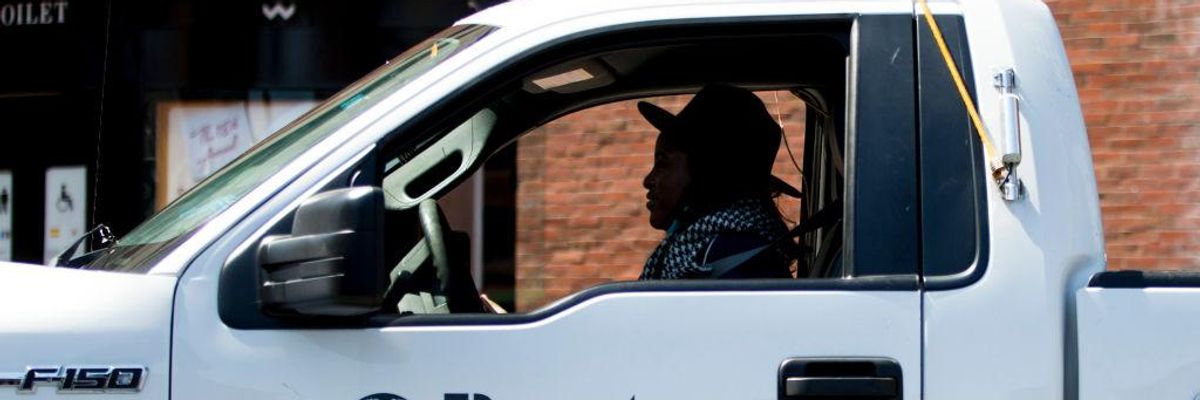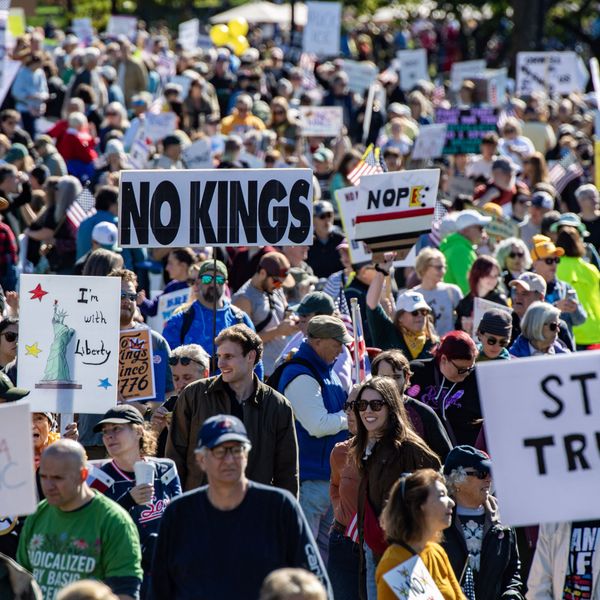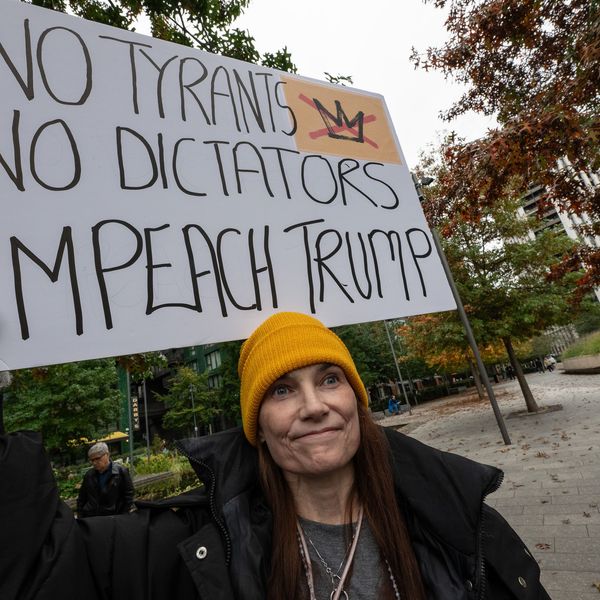
Jessica Thomas, Roxbury Liaison for Mayor Marty Walsh, is silhouetted as she leaves City Hall to drive her speaker truck through Roxbury and surrounding areas broadcasting information to help residents stay safe in multiple languages during the COVID-19 epidemic in Boston on April 19, 2020. (Photo by Blake Nissen for The Boston Globe via Getty Images)
A Public-Health Crisis Demands Equitable Local News
During an emergency, trustworthy information is paramount, and inequitable access is deadly.
Never in my lifetime can I recall so many weighty questions triggering anxiety throughout the country. How will my children learn today? What will happen if next month's bills go unpaid? What measures can I take to keep me and my community healthy?
Millions of people are struggling to find answers.
How many millions? In California alone, 72 percent of residents, or 29 million people, belong to groups the Census Bureau describes as "hard to count." That means the majority of Californians face barriers to accessing news and information and participating in civic affairs.
This includes people without secure housing, those who have limited English proficiency, children, undocumented immigrants, low-income people and those without home internet. For them, the coronavirus is among countless issues they may never receive essential information about.
There are numerous reasons for this. But a big one -- and one that has yet to garner attention from public officials -- is the collapse of the newspaper business, which has diminished reporting resources and led to growing inequities in news and information.
Since 2004, one in five local newspapers across the United States has closed, leaving too many communities without the news they need to stay informed and connected. This trend has hit communities of color, low-income communities and rural populations the hardest, as publishers prioritize journalism that serves audiences who can pay subscriptions, make donations or have the kind of spending power that appeals to advertisers.
Hundreds of remaining outlets have dramatically reduced staffing and shifted to online-only access, leaving the elderly and those without home internet in the dark. It's no wonder your older relatives are most likely to fall for conspiracy theories circulating on Facebook. For too many people, the sources they once relied on for information are simply no longer around.
The lack of trusted news sources, high level of uncertainty and speed at which misinformation travels are creating what the World Health Organization has described as an "infodemic". Efforts to address COVID-19 must focus not only on those most at risk of contracting and spreading the virus, but those most at risk of falling victim to misinformation.
But we don't need a pandemic to expose who gets critical information, who doesn't and what's at stake.
During the 2019 fire season, housekeepers went to work in the L.A. hills because they never received word of evacuation orders. Two years before that, farmworkers harvested crops throughout California while thick smoke blew over the fields. In both cases, news and safety alerts failed to reach those most at risk of breathing the toxic air.
Will we once again stand by while essential public-health information is available only to some? Or will we invest in solutions to make trustworthy news available to everyone?
One model can be found in New Jersey, where my Free Press Action colleagues led a grassroots campaign to invest public funding in local news and civic-information initiatives, particularly ones that serve historically overlooked communities. It's the sort of funding Free Press Action is calling for as part of a journalism stimulus from Congress.
Just imagine how that kind of support could disrupt the disinformation campaigns circulating online; how it could help reliable news reach those living in their cars and on the streets; and how it could support the translation and distribution of public-health information for residents who don't speak English, including California's growing communities of Mayan, Mixteco and Triqui speakers.
During an emergency, trustworthy information is paramount, and inequitable access is deadly. Now is the time to imagine, create and support local news that reaches our most vulnerable residents not only during a crisis, but year round.
An Urgent Message From Our Co-Founder
Dear Common Dreams reader, The U.S. is on a fast track to authoritarianism like nothing I've ever seen. Meanwhile, corporate news outlets are utterly capitulating to Trump, twisting their coverage to avoid drawing his ire while lining up to stuff cash in his pockets. That's why I believe that Common Dreams is doing the best and most consequential reporting that we've ever done. Our small but mighty team is a progressive reporting powerhouse, covering the news every day that the corporate media never will. Our mission has always been simple: To inform. To inspire. And to ignite change for the common good. Now here's the key piece that I want all our readers to understand: None of this would be possible without your financial support. That's not just some fundraising cliche. It's the absolute and literal truth. We don't accept corporate advertising and never will. We don't have a paywall because we don't think people should be blocked from critical news based on their ability to pay. Everything we do is funded by the donations of readers like you. Will you donate now to help power the nonprofit, independent reporting of Common Dreams? Thank you for being a vital member of our community. Together, we can keep independent journalism alive when it’s needed most. - Craig Brown, Co-founder |
Never in my lifetime can I recall so many weighty questions triggering anxiety throughout the country. How will my children learn today? What will happen if next month's bills go unpaid? What measures can I take to keep me and my community healthy?
Millions of people are struggling to find answers.
How many millions? In California alone, 72 percent of residents, or 29 million people, belong to groups the Census Bureau describes as "hard to count." That means the majority of Californians face barriers to accessing news and information and participating in civic affairs.
This includes people without secure housing, those who have limited English proficiency, children, undocumented immigrants, low-income people and those without home internet. For them, the coronavirus is among countless issues they may never receive essential information about.
There are numerous reasons for this. But a big one -- and one that has yet to garner attention from public officials -- is the collapse of the newspaper business, which has diminished reporting resources and led to growing inequities in news and information.
Since 2004, one in five local newspapers across the United States has closed, leaving too many communities without the news they need to stay informed and connected. This trend has hit communities of color, low-income communities and rural populations the hardest, as publishers prioritize journalism that serves audiences who can pay subscriptions, make donations or have the kind of spending power that appeals to advertisers.
Hundreds of remaining outlets have dramatically reduced staffing and shifted to online-only access, leaving the elderly and those without home internet in the dark. It's no wonder your older relatives are most likely to fall for conspiracy theories circulating on Facebook. For too many people, the sources they once relied on for information are simply no longer around.
The lack of trusted news sources, high level of uncertainty and speed at which misinformation travels are creating what the World Health Organization has described as an "infodemic". Efforts to address COVID-19 must focus not only on those most at risk of contracting and spreading the virus, but those most at risk of falling victim to misinformation.
But we don't need a pandemic to expose who gets critical information, who doesn't and what's at stake.
During the 2019 fire season, housekeepers went to work in the L.A. hills because they never received word of evacuation orders. Two years before that, farmworkers harvested crops throughout California while thick smoke blew over the fields. In both cases, news and safety alerts failed to reach those most at risk of breathing the toxic air.
Will we once again stand by while essential public-health information is available only to some? Or will we invest in solutions to make trustworthy news available to everyone?
One model can be found in New Jersey, where my Free Press Action colleagues led a grassroots campaign to invest public funding in local news and civic-information initiatives, particularly ones that serve historically overlooked communities. It's the sort of funding Free Press Action is calling for as part of a journalism stimulus from Congress.
Just imagine how that kind of support could disrupt the disinformation campaigns circulating online; how it could help reliable news reach those living in their cars and on the streets; and how it could support the translation and distribution of public-health information for residents who don't speak English, including California's growing communities of Mayan, Mixteco and Triqui speakers.
During an emergency, trustworthy information is paramount, and inequitable access is deadly. Now is the time to imagine, create and support local news that reaches our most vulnerable residents not only during a crisis, but year round.
Never in my lifetime can I recall so many weighty questions triggering anxiety throughout the country. How will my children learn today? What will happen if next month's bills go unpaid? What measures can I take to keep me and my community healthy?
Millions of people are struggling to find answers.
How many millions? In California alone, 72 percent of residents, or 29 million people, belong to groups the Census Bureau describes as "hard to count." That means the majority of Californians face barriers to accessing news and information and participating in civic affairs.
This includes people without secure housing, those who have limited English proficiency, children, undocumented immigrants, low-income people and those without home internet. For them, the coronavirus is among countless issues they may never receive essential information about.
There are numerous reasons for this. But a big one -- and one that has yet to garner attention from public officials -- is the collapse of the newspaper business, which has diminished reporting resources and led to growing inequities in news and information.
Since 2004, one in five local newspapers across the United States has closed, leaving too many communities without the news they need to stay informed and connected. This trend has hit communities of color, low-income communities and rural populations the hardest, as publishers prioritize journalism that serves audiences who can pay subscriptions, make donations or have the kind of spending power that appeals to advertisers.
Hundreds of remaining outlets have dramatically reduced staffing and shifted to online-only access, leaving the elderly and those without home internet in the dark. It's no wonder your older relatives are most likely to fall for conspiracy theories circulating on Facebook. For too many people, the sources they once relied on for information are simply no longer around.
The lack of trusted news sources, high level of uncertainty and speed at which misinformation travels are creating what the World Health Organization has described as an "infodemic". Efforts to address COVID-19 must focus not only on those most at risk of contracting and spreading the virus, but those most at risk of falling victim to misinformation.
But we don't need a pandemic to expose who gets critical information, who doesn't and what's at stake.
During the 2019 fire season, housekeepers went to work in the L.A. hills because they never received word of evacuation orders. Two years before that, farmworkers harvested crops throughout California while thick smoke blew over the fields. In both cases, news and safety alerts failed to reach those most at risk of breathing the toxic air.
Will we once again stand by while essential public-health information is available only to some? Or will we invest in solutions to make trustworthy news available to everyone?
One model can be found in New Jersey, where my Free Press Action colleagues led a grassroots campaign to invest public funding in local news and civic-information initiatives, particularly ones that serve historically overlooked communities. It's the sort of funding Free Press Action is calling for as part of a journalism stimulus from Congress.
Just imagine how that kind of support could disrupt the disinformation campaigns circulating online; how it could help reliable news reach those living in their cars and on the streets; and how it could support the translation and distribution of public-health information for residents who don't speak English, including California's growing communities of Mayan, Mixteco and Triqui speakers.
During an emergency, trustworthy information is paramount, and inequitable access is deadly. Now is the time to imagine, create and support local news that reaches our most vulnerable residents not only during a crisis, but year round.

